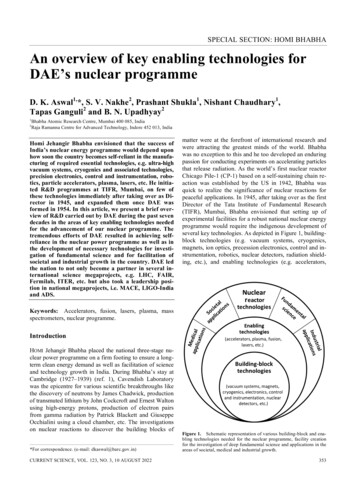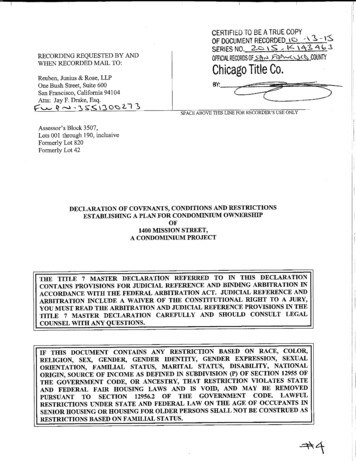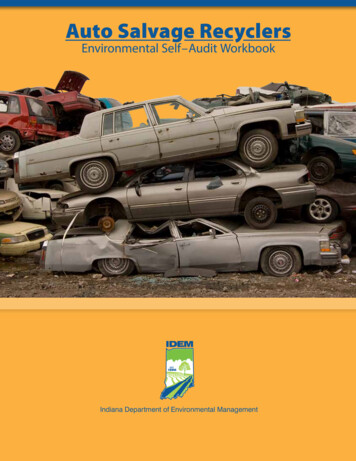
Transcription
SPECIAL SECTION: HOMI BHABHAAn overview of key enabling technologies forDAE’s nuclear programmeD. K. Aswal1,*, S. V. Nakhe2, Prashant Shukla1, Nishant Chaudhary1,Tapas Ganguli2 and B. N. Upadhyay212Bhabha Atomic Research Centre, Mumbai 400 085, IndiaRaja Ramanna Centre for Advanced Technology, Indore 452 013, IndiaHomi Jehangir Bhabha envisioned that the success ofIndia’s nuclear energy programme would depend uponhow soon the country becomes self-reliant in the manufacturing of required essential technologies, e.g. ultra-highvacuum systems, cryogenics and associated technologies,precision electronics, control and instrumentation, robotics, particle accelerators, plasma, lasers, etc. He initiated R&D programmes at TIFR, Mumbai, on few ofthese technologies immediately after taking over as Director in 1945, and expanded them once DAE wasformed in 1954. In this article, we present a brief overview of R&D carried out by DAE during the past sevendecades in the areas of key enabling technologies neededfor the advancement of our nuclear programme. Thetremendous efforts of DAE resulted in achieving selfreliance in the nuclear power programme as well as inthe development of necessary technologies for investigation of fundamental science and for facilitation ofsocietal and industrial growth in the country. DAE ledthe nation to not only become a partner in several international science megaprojects, e.g. LHC, FAIR,Fermilab, ITER, etc. but also took a leadership position in national megaprojects, i.e. MACE, LIGO-Indiaand ADS.matter were at the forefront of international research andwere attracting the greatest minds of the world. Bhabhawas no exception to this and he too developed an enduringpassion for conducting experiments on accelerating particlesthat release radiation. As the world’s first nuclear reactorChicago Pile-1 (CP-1) based on a self-sustaining chain reaction was established by the US in 1942, Bhabha wasquick to realize the significance of nuclear reactions forpeaceful applications. In 1945, after taking over as the firstDirector of the Tata Institute of Fundamental Research(TIFR), Mumbai, Bhabha envisioned that setting up ofexperimental facilities for a robust national nuclear energyprogramme would require the indigenous development ofseveral key technologies. As depicted in Figure 1, buildingblock technologies (e.g. vacuum systems, cryogenics,magnets, ion optics, precession electronics, control and instrumentation, robotics, nuclear detectors, radiation shielding, etc.), and enabling technologies (e.g. accelerators,Keywords: Accelerators, fusion, lasers, plasma, massspectrometers, nuclear programme.IntroductionHOMI Jehangir Bhabha placed the national three-stage nuclear power programme on a firm footing to ensure a longterm clean energy demand as well as facilitation of scienceand technology growth in India. During Bhabha’s stay atCambridge (1927–1939) (ref. 1), Cavendish Laboratorywas the epicentre for various scientific breakthroughs likethe discovery of neutrons by James Chadwick, productionof transmuted lithium by John Cockcroft and Ernest Waltonusing high-energy protons, production of electron pairsfrom gamma radiation by Patrick Blackett and GiuseppeOcchialini using a cloud chamber, etc. The investigationson nuclear reactions to discover the building blocks of*For correspondence. (e-mail: dkaswal@barc.gov.in)CURRENT SCIENCE, VOL. 123, NO. 3, 10 AUGUST 2022Figure 1. Schematic representation of various building-block and enabling technologies needed for the nuclear programme, facility creationfor the investigation of deep fundamental science and applications in theareas of societal, medical and industrial growth.353
SPECIAL SECTION: HOMI BHABHAplasma, fusion, lasers, etc.) are needed for the development of nuclear reactor technologies for basic research,radioisotope production and power generation. The knowhow gained during the development of these indigenoustechnologies is also vital for the setting up of national facilities for the investigation of fundamental science as well asfor strategic, medical, societal and industrial applications.As India’s nuclear programme was to be started fromscratch, Bhabha took a visionary initiative by nucleatingR&D activities on the development of a few building-blocktechnologies at TIFR. In 1954, as the first Secretary of theDepartment of Atomic Energy (DAE), he expanded theseR&D activities to a full scale at the Bhabha Atomic Research Centre (BARC), Mumbai to build a robust, self-reliant nuclear programme in the country. In due course oftime, these R&D activities were further expanded to variousother units of DAE, namely Raja Ramana Centre for Advanced Technology (RRCAT), Variable Energy CyclotronCentre (VECC), Saha Institute of Nuclear Physics (SINP),Institute of Plasma Research (IPR), Indira Gandhi Centrefor Atomic Research (IGCAR), etc. Due to the obstinateR&D efforts of DAE, India is now self-reliant in most ofthese enabling technologies required for nuclear industries. In this article, we present a brief overview of theseachievements. Many offshoots of DAE’s R&D activitiesare being gainfully utilized for medical, societal and industrial growth. We also briefly highlight DAE’s contributions to international mega science and technologyprojects, and show that India is on a path to becoming atechnologically advanced nation.Particle accelerator technologiesDuring the past seven decades, DAE units have set upseveral modern particle accelerator facilities for their nuclearprogramme as well as for basic, applied and industrial applications. Both linear and circular type of acceleratorshave been developed/set up, including Cockroft–Walton, Vande Graaff, tandem Pelletron, linear accelerators (LINAC),cyclotron and synchrotron. Table 1 summarizes the majormilestones of accelerator development in DAE. In the literature, DAE’s accelerator programme has extensivelybeen reviewed from time to time2,3. Therefore, here wewill present only a brief overview. These accelerators playa vital role in a variety of scientific and societal applications, viz. basic nuclear physics research, materials processing and characterization, health and medicine (bothfor diagnostics and treatment), food, agriculture, strategic,nuclear power and industrial applications.Accelerators for research, medical, societal andindustrial applicationsAs summarized in Table 1, DAE’s particle accelerator facilities are being routinely used for basic nuclear and con354densed matter research as well as for medical, societal andindustrial applications. In particular, electron beam andradioisotopes are making a big impact in the diagnosticsand treatment of cancer. To cater the ever-increasing demand for medical radioisotopes, VECC is setting up anAdvanced National facility for Unstable Rare IsotopeBeam (ANURIB) in Kolkata. This facility will also be utilized for studies related to nuclear spectroscopy, materialsscience and radiobiology4. Indigenously developed electron accelerators are widely used for radiation processingof food commodities, mutation of seeds, development ofbio-stimulators for different crops, sterilization of disposable medical products, etc.5,6. The irradiation of food items(fruits, vegetables, spices, cereals, etc.) enhances theirshelf-life mainly by killing the microbes and sprout inhibition. Electron-beam facilities are also utilized by industries for polymer cross-linking which immensely improvestheir thermal and mechanical properties. The cross-linkedpolymers are utilized in the development of products likewires, cables, hydrogels, vulcanized rubber, plastic foam,composite materials, etc. In addition, electron beams findunique industrial applications in producing exotic coloursin gemstones, semiconductor characteristics amendments,wastewater treatment, electron-beam welding for manufacturing special components, etc.7. Electron acceleratorshave been used for testing of nuclear waste depositorymaterials, photoactivation and fission analysis, device performance enhancement and radiation sustainability studies8,9. DAE has recently developed a cargo scanning systemfor imaging of cargos to avoid the transport of contrabandobjects. Internal images of cargos with material discrimination features, are generated with X-rays which are produced by dual-energy (6 and 4 MeV) electron LINAC havinga pulse-to-pulse energy variation flair.Accelerators for material characterizationIndus-1 and Indus-2 synchrotron radiation facilities arebeing profoundly utilized by researchers from universities,R&D organizations and industries for a deeper understanding of the internal structure of matter and its correlationwith physical properties10. These facilities provide a widerange of techniques for materials characterization. Majortechniques with Indus-1 are high-resolution ultraviolet spectroscopy, angle integrated photoelectron spectroscopy,angle-resolved photoelectron spectroscopy, X-ray reflectivity, infrared spectroscopy, etc. The major beamlines ofIndus-2 are soft X-ray absorption, engineering applicationsbeamline, soft X-ray reflectivity, X-ray imaging beamline,X-ray lithography beamline, dispersive and scanning EXAFSbeamline, angle-resolved photoelectron spectroscopy, extreme conditions XRD, angle dispersive XRD, hard X-rayphotoemission spectroscopy, X-ray fluorescence microprobe, small and wide-angle X-ray scattering, protein crystallography. These facilities have allowed researchers toexplore the exciting developments in understanding ofCURRENT SCIENCE, VOL. 123, NO. 3, 10 AUGUST 2022
SPECIAL SECTION: HOMI BHABHATable 1.Year19501957Major milestones of particle accelerator development at DAE in chronological ionPurpose19881 MV Cockroft–WaltonLow-energy cascadegenerator38-inch cyclotron5.5 MV Van de GraaffCockroft–WaltonK130 room-temperaturecyclotron2 MV tandemVan de Graaff7 MeV linear accelerator(LINAC)14 UD Pelletron19882 MeV ILU-61989KALI (Kilo Amperelinear injector)3 MV tandem ionaccelerator500 keVCockroft–Walton450 MeV SynchrotronIndus 15.5 MV folded tandemion accelerator16.5 MeV medicalcyclotron accelerator1.7 MV tandemaccelerator10 MeV LINACElectron1 MeVIons3 MeVElectron500 keVElectron450 MeVProton; ions(A 40)H– and D–ionsIon6 MeV;66 MeV16.5 MeVElectron10 MevRMC/BARC,MumbaiIGCAR,KalpakkamRRCAT, Indore2.5 GeV SynchrotronIndus 2750 keVCockroft–Walton10 MeV LINACElectron2.5 GeVRRCAT, IndoreElectron750 keVRRCAT, IndoreElectron10 MeVBARC, EBC,Navi MumbaiK500 superconductingcyclotron9 MeV LINACCompact UltrafastTerahertz Free ElectronLaser (CUTE-FEL)1–3 MeV DynamitronIonK 500*VECC, KolkataElectronElectron9 MeV10 MeVECIL, HyderabadRRCAT, IndoreCargo scanning and neutron radiographyResearch and technology development(decommissioned in 2016)Electron3 MeVElectron24 MeVFlue gas treatment, curing of rubber tiles andradiation hardening studiesResearch, especially in condensed matter physics2017Infra-Red Free ElectronLaser (IR-FEL)6 MeV LINACBARC, EBC,Navi MumbaiRRCAT, IndoreElectron6 MeVCargo scanning and radiography20182018Proton cyclotronLEHIPA FacilityProtonProton30 MeV3 MeVBARC, EBC,Navi MumbaiVECC, KolkataBARC, on1 MeV400 keVTIFR, MumbaiSINP, KolkataBasic nuclear physics researchNeutron generationProtonProtonProtonIon4 MeV5.5 MeV300 keVK 130*SINP, KolkataBARC, MumbaiBARC, MumbaiVECC, KolkataIon2 MeVBARC, MumbaiNuclear physics and spectroscopy experimentsNuclear physics experimentsNeutron generationNuclear physics research, radiation damage study,isotope production and detector studiesResearch in nuclear physics and atomic spectroscopyElectron7 MeVBARC, MumbaiResearch in chemistry and materials scienceProton; ions(A 37)Electron24 MeV;10 MeV/A#2 MeVTIFR, MumbaiNuclear physics, condensed matter physics, atomicand molecular physicsIndustrial irradiation applications for polymers,rubbers, cables, etc.Strategic and industrial applications2 MeV20192022BARC, BRIT,Navi MumbaiBARC, MumbaiNCCCM,HyderabadBARC, BRIT,Navi MumbaiRRCAT, IndoreBARC, MumbaiMaterial surface analysisSurface treatment of polymers, textiles and rubbertilesBasic research in physics, materials, chemistry,pharmaceuticals, environment, etc.Research in nuclear physics, radiation biology,materials science and ion implantationProduction of radiotracer 18F for positron emissiontomographyIon implantation, ion beam analysis and materialsscienceIrradiation for sterilization of medical devices,irradiation of research samples for developmentof new crop varieties, colour modification of gemstones, development of novel materials, etc.Basic research in physics, materials, chemistry,pharmaceuticals, environment, etc.Surface treatments of rubber tiles, curing of paints andcoated woodIrradiation of various products like polymers,semiconductors, gemstone colour enhancements,seed mutation, food preservation, radiationhardening studies and basic researchIon beam and nuclear physics researchRadioisotope production to treat cancerNuclear physics and accelerator-driven sub-criticalnuclear reactorsIrradiation of different food and medical productsCargo scanning with material discrimination facility10 MeV LINACElectron10 MeVRRCAT, Indore6/4 MeV dual energyElectron6 MeVBARC, EBC,LINACNavi Mumbai2022High powerElectron1 MeVBARC, EBC,Wastewater treatmentCockroft–WaltonNavi Mumbai*K value: In case of cyclotron, maximum possible energy of a particle with that particular accelerator is generalized in terms of the K value as K.E. K(Q2/A); where K is a constant (reflects in ‘MeV’), Q is the charge state of the particle and #A is the number of nucleons.CURRENT SCIENCE, VOL. 123, NO. 3, 10 AUGUST 2022355
SPECIAL SECTION: HOMI BHABHAmaterials in the areas of solar cells, nuclear materials, nanomaterials, thin films and interfaces, medicine, fuels,pharmaceuticals and the environment11. Typically, morethan 900 user experiments are carried out annually at theIndus beamlines, with a total of about 175 publications ininternational journals each year. Users from about 150 different institutions and 10 different industries have usedthese beamlines at Indus-1 and Indus-2. DAE has also developed several state-of-the-art accelerator-based techniquessuch as accelerator mass spectrometry (AMS), Rutherfordbackscattering (RBS), proton-induced X-ray emission(PIXE), nuclear reaction analysis (NRA) and elastic recoildetection analysis (ERDA) for basic studies in materialscience12.Accelerators for strategic applicationsGeneration of pulsed, high-power (several gigawatts) relativistic electron beam is needed to produce flash X-rays,pulsed neutron sources, high-power microwaves and pulsed ion sources, which in turn are used for strategic as wellas industrial applications, including futuristic use in thermonuclear fusion devices for energy generation. BARChas developed an intense pulsed electron accelerator namedas Kilo Ampere Linear Injector (KALI) with its many versions like KALI 75, KALI 85, KALI 200, KALI 1000, andKALI 5000. It is capable of generating powerful pulsedelectron beam of duration 50–100 ns with energies of 0.2–1 MeV and power up to 30 GW (ref. 13).Accelerator-driven subcritical reactor system (ADS)DAE has an undergoing project on ADS, which is likelyto have a major impact on the nuclear energy scenario14.ADS relies on spallation neutrons, produced by a 1 GeVproton accelerator, driving a subcritical nuclear reactor.The system has increased safety and can use fuel with degraded neutronic properties. It can find applications infuel breeding and incineration of the long-lived actinideand fission product waste. ADS can advantageously beused with thorium fuel, which though not fissile is fertile,i.e. can be converted into fissile material using a neutronsource. The R&D activities of ADS have three major technologically distinct subsystems: (i) development of 1 GeV(10 mA CW) high-intensity proton accelerator (HIPA).For this, BARC has designed and established the LEHIPA(20 MeV, 10 mA) facility using indigenous radiofrequencyquadrupole (RFQ), drift-tube LINAC, RF power supplies,etc. RRCAT is working on the design and development ofa 1 GeV proton synchrotron for the generation of spallation neutrons. (ii) Heavy element targets that would produce spallation neutrons on bombarding with high energyproton, i.e. target materials taking a load of 10 MW ofheat energy. (iii) Sub-critical nuclear reactor for which356BARC has taken up innovative interdisciplinary R&Dprogrammes on power generation using ADS.International collaborationsDAE’s accelerator programme has led to the creation of coreexpertise on various aspects of accelerator development, i.e.design, fabrication, assembly, installation, integration, testing, commissioning and utilization. The manufacturingcapabilities of sub-components of accelerator systems likedifferent types of magnets, RF systems, power supplies,ultra-high vacuum systems, electron or ion sources, beamdiagnostics, cryogenics, controls and instrumentation, radiological shielding and other utilities have been developedin the country. In addition, owing to the execution capabilities of numerous large projects, DAE is a strong collaboratorin several mega international accelerator programmes.One of the major international efforts is to develop accelerators with higher possible energies, which are aimedat probing the structure of matter as deep as possible. As aresult, the Large Hadron Collider (LHC), the most powerfulaccelerator with proton energy of 8 TeV, has been builtnear Geneva, Switzerland15. DAE is an active partner inthe LHC programme16 and has contributed to the construction of LHC as well as its detectors – CMS (Compact MuonSolenoid) and ALICE (A Large Ion Collider Experiment).It has also contributed in almost all components of LHCsuch as superconducting magnets, vacuum systems, cryogenics, power supplies, control electronics, mechanicalsystems and so on. The experiments conducted using suchpowerful particle accelerators over time have explored thenucleus and shown scientifically that the basic buildingblocks of matter are the families of six quarks and six leptons. Such experiments have also enhanced our understanding of the basic operating forces in nature and led tothe discovery of the Higgs boson – an elementary particlein the Standard Model of particle physics. The Pb–Pb collisions of LHC created very high-temperature matter, whichwas supposed to exist a few microseconds after the BigBang, to understand the dynamics of fundamental particlesin bulk. The futuristic investigation in particle physics isnow to look into the unanswered questions of the origin ofdark matter and dark energy, the matter/antimatter asymmetry in the universe, and the unification of electroweak,strong forces and gravity.The Fermilab–DAE collaboration is aimed at the development of research facilities for proton accelerator projects in India. Under the Proton Improvement Plan II (PIP-II)project, Fermilab is supporting India in the developmentof a 1.2 MW proton beam for DUNE (Deep UndergroundNeutrino Experiment). Currently R&D work on the design,development and fabrication of various components suchas room-temperature magnets, single-spoke resonator cavities, cryogenics, RF protection system, high beta superconducting radiofrequency (SRF) cavity, 650 MHz solid-stateCURRENT SCIENCE, VOL. 123, NO. 3, 10 AUGUST 2022
SPECIAL SECTION: HOMI BHABHARF amplifiers, etc. is being taken up at BARC, RRCAT,VECC and other national institutions.DAE is also contributing to the Facility for Antiprotonand Ion Research (FAIR), which is an under-constructionaccelerator complex in Darmstadt, Germany. RRCAT hassupplied 127 power converters to the FAIR acceleratorthat were indigenously designed, developed, tested, andmanufactured. Other technical support provided includeslarge superconducting magnets, beam stoppers, vacuumchambers and sophisticated detectors for experiments,which have demonstrated unique expertise developed byDAE in the areas of accelerators.Plasma and fusion technologiesPlasma medium exhibits exotic properties, including highenthalpy and energy density, high temperature and steeptemperature gradient and the presence of reactive species.This makes plasma adaptable for a wide variety of materialssynthesis and surface engineering. DAE had initiated acomprehensive R&D programme at BARC on plasma physics and technology during its formative years with a focuson the development of plasma formation devices, plasmadiagnostics and instrumentation, plasma processing of materials, etc.17. The plasma and fusion research grew furtherwhen IPR (a research centre of DST) was moved to DAEin 1995 (ref. 18). Some of the developed plasma technologies include air and underwater plasma cutting systems,microwave plasma processing systems, plasma nitridingsystems, plasma-enhanced chemical vapour depositionsystems, plasma surface etching and cleaning techniques,plasma pyrolysis, plasma jets, etc. These plasma technologies are being deployed for solving many surface engineering and processing-related issues of the nuclearprogramme as well as for societal and industrial applications, including medical waste disposal.IPR is carrying out fusion research based on a Tokamakdevice that has a magnetically confined hot plasma.ADITYA, India’s first Tokamak, was commissioned in1989. All the components of tokamak devices, namely ultrahigh vacuum vessel ( 10–8 torr vacuum in a vessel having 16 m3 volume with 75 m2 surface area), pulsed powersystem (a peak power level of 50 MW), magnetic field coilsand the ohmic transformer were developed indigenously.ADITYA has a plasma of circular cross-section with amajor and minor radius of 0.75 and 0.25 m respectively. A100 kA plasma current is sustained for about 100 ms, toconfine and heat the plasma. Plasma is further heated usingan auxiliary RF system. Several diagnostics are deployedto measure various plasma parameters. ADITYA has beenupgraded recently to obtain improved performance. Forthis, a 28 GHz, 200 kW gyrotron-based electron cyclotronresonance heating (ECRH) system has been integrated.IPR has also established a state-of-the-art Steady StateSuperconducting Tokamak (SST-1), which is a large aspectCURRENT SCIENCE, VOL. 123, NO. 3, 10 AUGUST 2022ratio Tokamak and configured to run an elongated plasmacurrent of 200 kA with a pulse duration of 1000 s. Varioushighly specialized and sophisticated components of SST-1are indigenously manufactured in association with Indianindustries, including copper and NbTi superconductingmagnets, cryogenic technology, ultra-high vacuum systems,high heat flux removal technology, high-power RF technology and energetic neutral beam production and injection technologies.Since 2005, DAE is a partner to ITER (InternationalThermonuclear Experimental Reactor), which is an international nuclear megaproject aimed at carrying out researchand engineering on fusion processes to produce clean energy.Other partners of ITER are the European Union, China,Japan, Russia, South Korea and USA. ITER will be theworld’s largest tokamak nuclear fusion reactor which isbeing built in Cadarache, France. ITER-India is a specialproject under IPR and serves as the Indian DomesticAgency to design, build and deliver the Indian in-kindtechnological contribution to ITER. Some of the components delivered to ITER include 30 m high and 30 m diameter outer vacuum shell of ITER, several kilometreslong cryolines for ITER cryo-plants, blocks and plates ofborated steel (SS304B4, SS304B7), and ferritic steel forneutron shielding and reducing toroidal field ripple, RFsources, beam diagnostic system, power supplies, gyrotronsources, special materials like composition controlledCuCrZr, etc. These components are the first of their kindand are of high quality meeting the stringent nuclear safety norms of the Regulatory Board of France.Laser technologiesIn early sixties, DAE initiated a programme on the development of lasers, recognizing their importance as a tool ofgreat power and precision for various nuclear programmes.BARC succeeded in the development of a semiconductorlaser and demonstrated an optical communication linkover a distance of 20 km. The laser programme was expanded with the establishment of dedicated R&D activities at RRCAT in 1986. RRCAT has developed a widerange of lasers, e.g. CO2, nitrogen, Nd : glass, dye, etc. andutilized them for the investigation of materials processing,laser–plasma interactions, resonance ionization spectroscopy, nonlinear optics, etc.19.High-power pulsed lasers are needed for highly specialized tasks in nuclear and other industries, e.g. laser cutting,drilling and milling; laser cleaning; laser welding and soldering; laser marking and engraving; laser cladding orcoating; laser surface modification and laser hardening;laser sintering, etc. RRCAT has indigenously developed500 Hz pulsed TEA (transversely excited atmosphericpressure) CO2 lasers with average power up to 500 W andpulsed Nd : YAG lasers of 250 W average power (5 kWpeak power with multi-port time-shared fibre optic beam357
SPECIAL SECTION: HOMI BHABHAdelivery). A few examples of classic applications of lasersin nuclear power plants are: (i) laser cutting of bellow lipsduring en masse coolant channel replacement (EMCCR)in nuclear reactors that substantially reduced the downtime. (ii) Laser-based technique for removal of any selectedcoolant channel in pressurized heavy water reactors(PHWRs) as well as for life assessment of pressure tubes.(iii) Underwater laser cutting of pressure tube stubs. Theselaser-based applications have enormously reduced radiation dose consumption, time and cost20. The developed laserswere also deployed for societal applications, e.g. weldingof heart pacemaker, micro-welding of low dose I125brachytherapy encapsulation for eye and prostate cancer,micro-welding of Ir192 high dose rate brachytherapy assemblies for treatment of internal organ cancer, etc.21. The developed high-performance copper vapour laser systemsare used for the fabrication of fibre-based sensors, whichare finding applications in areas like railway safety, temperature monitoring in high radiation fields, structuralhealth monitoring, etc.22. A monolithic single-mode, 1 kWCW Yb-doped fibre laser has been developed for additivemanufacturing of niche components which have a gradedmaterial structure or complicated structures that cannot bemanufactured by conventional techniques23,24.Mass spectrometer technologiesThe success of various stages of the nuclear fuel cycle requires mass spectrometers for the measurement of elementsat the ultra-trace level along with isotope ratios in samplesof hydrogen, lithium, boron, uranium, plutonium, etc. Thus,mass spectrometry is a crucial analytical tool for the determination of burn-up of fuel, nuclear materials accounting, nuclear environmental monitoring, migration studies,dating and radioactive waste control. BARC has indigenously developed various types of highly sophisticated massspectrometers having a quality of international equivalence25. These include: (i) Thermal ionization mass spectrometer (TIMS) utilized for the determination of isotopicabundances of Li, B, U and Pu isotopes in solid samples.(ii) Inductively coupled plasma source mass spectrometer(ICPMS) used for trace, ultra-trace, isotope ratio analysisof elements in aqueous samples. The detection limit ofICPMS is parts per trillion for most of the elements. (iii)Process gas mass spectrometer used for the measurementof isotopic abundance of uranium isotopes 234, 235 and238 corresponding to natural, enriched and depleted respectively, (iv) D/H mass spectrometer used for the determination of deuterium (D) to hydrogen (H) ratio andessential for the production of high-quality heavy water.(v) Time-of-flight mass spectrometer (TOF MS) which issensitive to femtomole amounts of a sample. Apart fromthe nuclear industry, these mass spectrometers find applications in basic research, forensics, environmental scienceand geology as well as in various industries like petroleum,pharmaceutical, chemical, petrochemical, etc.358Radiation monitoring systemsAnother hallmark of Bhabha’s vision was to safeguard radiation workers and the environment from any harmful effectsof radiation. For this, BARC indigenously developed various types of radiation detectors, e.g. gas-filled, solid-state,scintillation detectors, chemical dosimeters, thermoluminescence dosimeters, neutron detectors, etc. as well as radiation monitoring and surveillance network. In addition, fornational nuclear and radiological safety, technologies forradiation monitoring and surveillance were developed anddeployed countrywide. These are: (i) IERMON (IndianEnvironmental Radiation Monitoring Network) consistingof standalone GM tube-based gamma-ray monitoring stations and solar-powered, battery-operated systems withglobal system for mobile (GSM) and/or satellite-baseddirect communication systems26. To detect fallout radionuclides in the atmosphere from any nuclear/radiologicalevents, IERMON is supported by the EnvironmentalGamma Spectrometry System (EGSS), which consists ofscintillator-based gamma spectrometers. IERMON is compact, rugged, meant for open-field deployment and hassuccessfully withstood the varying environmental conditions across the country. Over 500 IERMON systems havebeen deployed countrywide for 24 7 unattended monitoring of natural background radioactivity, detection ofpossible transboundary migration, surveillance around nuclear facilities (mining, nuclear power plants, etc.), detectionof any nuclear/radiological events in metropolitan cities,etc. (ii) For radiation surveillance underwater, special environmental radiation monitors (ERM) integrated with anautonomous vertical profiler (AVP) have been developed,which are battery-operated, store the data and communicate them using RF once they come to the surfa
vity, infrared spectroscopy, etc. The major beamlines of Indus-2 are soft X-ray absorption, engineeringapplications beamline, soft X-ray reflectivity, X-ray imaging beamline, X-ray lithography beamline, dispersive and scanning EXAFS beamline, angle-resolved photoelectron spectroscopy, ex--ray X photoemission spectroscopy, X-ray fluorescence micro-










